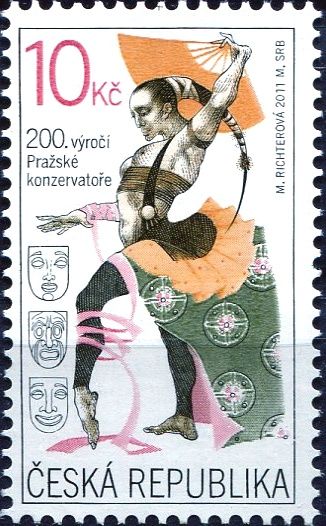- Home
- Philately: postage stamps
- Philately: stamps of the Czech Republic
- Czech Republic
- Net
- 2011
- (2011) MiNo. 678 ** - Czech Republic - 200th anniversary of teaching at the Prague Conservatory
(2011) MiNo. 678 ** - Czech Republic - 200th anniversary of teaching at the Prague Conservatory
Czech Republic - postage stamps

| Code: | cz679 |
| Producer: | Česká pošta |
| Price: | 0,52 EUR |
| Availability: | In Stock |
| Stock: | 1 Pcs |
| Year: | 2011 |
| Condition: | ** |
| Cat. number (POFIS): | 679 |
| Catalogue no. (MICHEL): | 678 |
| Cat. number (St. Gibbons): | 651 |
| Cat. number (Yvert et Tellier): | 602 |
200 years of teaching at the Prague Conservatoire: An Important Chapter in European Music History
The Prague Conservatoire, founded in 1811 and starting teaching in 1811/1812, is one of the oldest music schools in Europe. Its history dates back to the Napoleonic Wars and the Enlightenment, when there was a growing demand for systematic music education in Europe. The Conservatoire played a key role in shaping Czech and European musical identity and over the course of two centuries educated hundreds of musicians whose influence extended far beyond the borders of the Habsburg monarchy.
Founding and Early Years
The impetus for the founding of the conservatory was the efforts of the Society of Friends of Music (Gesellschaft der Musikfreunde), which wanted to create a solid foundation for the professional training of musicians in the Czech lands. Initially, teaching was based on the Viennese model and included subjects such as violin, cello, double bass, bassoon, clarinet and flute. Emphasis was also placed on music theory, harmony and counterpoint.
Significant alumni and teachers
Over the course of two centuries, the Conservatoire has produced a number of figures who have had a major impact on the world music scene. Among the most notable alumni is Antonín Dvořák, whose work as a teacher and composer enhanced the school's prestige. Other famous names are Josef Suk, Rafael Kubelík or Karel Ančerl. Among the teachers we can mention Josef Bohuslav Foerster, Otakar Ševčík and František Ondříček.
Influence on Czech music and culture
The Prague Conservatoire played a fundamental role in the formation of the so-called Czech School of Music. In the 19th century, it contributed to the national revival by educating musicians who actively contributed to the creation of Czech cultural identity. The school also fostered the interconnection between music, literature and theatre - for example, by teaching opera singing and conducting.
Transformations of teaching in the 20th and 21st centuries
After 1918, teaching adapted to the needs of the newly formed Czechoslovak Republic. In the inter-war period, musical trends expanded and there was a greater interest in contemporary music. After 1948, the Conservatoire faced the pressure of ideologisation, but managed to maintain a high level of teaching. Today it offers a wide range of disciplines, including composition, conducting, singing, historical performance and music drama.
International importance
The Prague Conservatory continues to maintain its high standards and actively collaborates with music schools in Europe and overseas. It participates in international exchange programmes, hosts renowned teachers and organises concerts, competitions and conferences. Its students and graduates perform on prestigious stages from Berlin to Tokyo.
From the Same Category - (2011) MiNo. 678 ** - Czech Republic - 200th anniversary of teaching at the Prague Conservatory
Czech Republic postage stamps
Czech Republic - postage stamps Pat and Mat - The Unlikely Generations Pat and Mat are iconic characters of Czech animation who entertain audiences with their endless ingenuity, but also their mischief. These two do-it-yourselfers first appeared in ...
Coupon 2 ( K1 + 1 + K1)